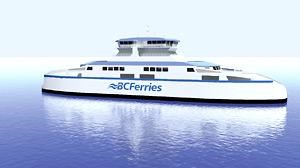Contracts have been let for three new ferries, including the replacement vessel for Queen of Burnaby, serving Powell River to Comox.
A total of $165 million in contracts were awarded to Remontowa Shipbuilding S.A. of Gdansk, Poland for three new intermediate class vessels. The new vessels are 105 metres in length and will each accommodate 145 vehicles and 600 passengers. The first is scheduled to arrive in BC in August 2016, the second in October 2016 and the third in February 2017. BC Ferries has not indicated whether the first ferry will serve the Powell River—Comox route or the Tsawwassen—Southern Gulf Islands route.
Kim Barton-Bridges, interim co-chair of the Northern Sunshine Coast Ferry Advisory Committee (FAC), said the committee had been told the ferries could not be built in British Columbia because the shortlisted shipyard in this province was already committed to other projects.
“It would have been great to offer that job to BC builders but they were already busy,” Barton-Bridges said. FAC had asked questions of BC Ferries about the reasons for the vessels being built offshore. She understands the winning shipbuilder has experience in building vessels that can handle adverse weather conditions.
“I think they’ll do a good job,” she said.
The fact the ferries will be delivered beginning in August 2016 is good news for local travellers, Barton-Bridges said.
It appears BC Ferries listened when FAC voiced concerns about the new class of ferries, she added. For example, the MV Island Sky, which serves the Saltery Bay—Earl’s Cove route, is an open design, and travellers can get wet in adverse conditions. There was suggestion that the new ferries be more enclosed so that families do not have to “brave the elements” to get inside the vessel.
“There were lots of things we mentioned and they were going to take that all into consideration,” she said.
City of Powell River Mayor Dave Formosa said the fact the vessel is being built in Poland is about fiscal responsibility. “Seaspan has indicated they don’t have the capacity. I don’t know who else would,” he said. “It looks like with the design, they are taking into consideration the concerns of the community. The sides of the ship come up and wing over. We’ve been given assurances we won’t have an issue about spray on the vehicles.”
The new ferries will be capable of using liquefied natural gas (LNG) and diesel fuel for propulsion and power generation. Fueling the vessels with LNG will help keep operational costs down.
“I’ll be excited to see a new ferry and to see it docked here,” Formosa said. “It’s something that this community, and I believe Bowen Island, would like to see.” Those are the only two communities in the BC Ferries system not served with the ferries originating and concluding at their own docks, Formosa said.
He added that the new ferry should ensure a higher frequency of sailings than the Queen of Burnaby.
“We are at such a high rate of cancellations because the vessel has been downgraded and it’s old, it’s not as reliable,” Formosa said. “When this new vessel comes it will be business as usual in Powell River.”
This new shipbuilding process will help BC Ferries standardize its fleet.
“Standardization offers greater interoperability and lower crew training and maintenance costs, and it also enhances safety,” said Mark Wilson, BC Ferries vice-president of operations. “This is a significant step forward in taking BC Ferries from 17 classes of ships to five.”



